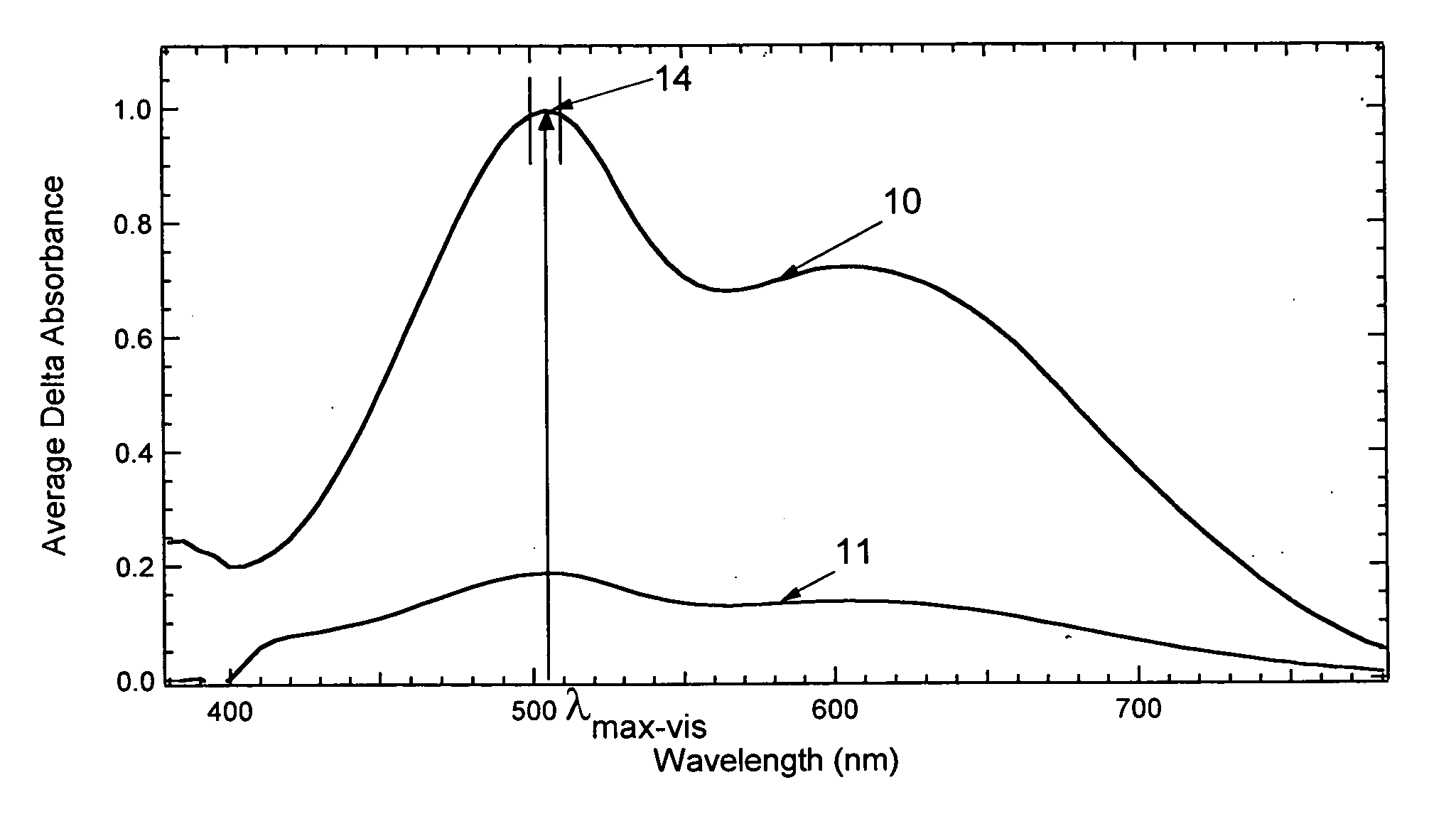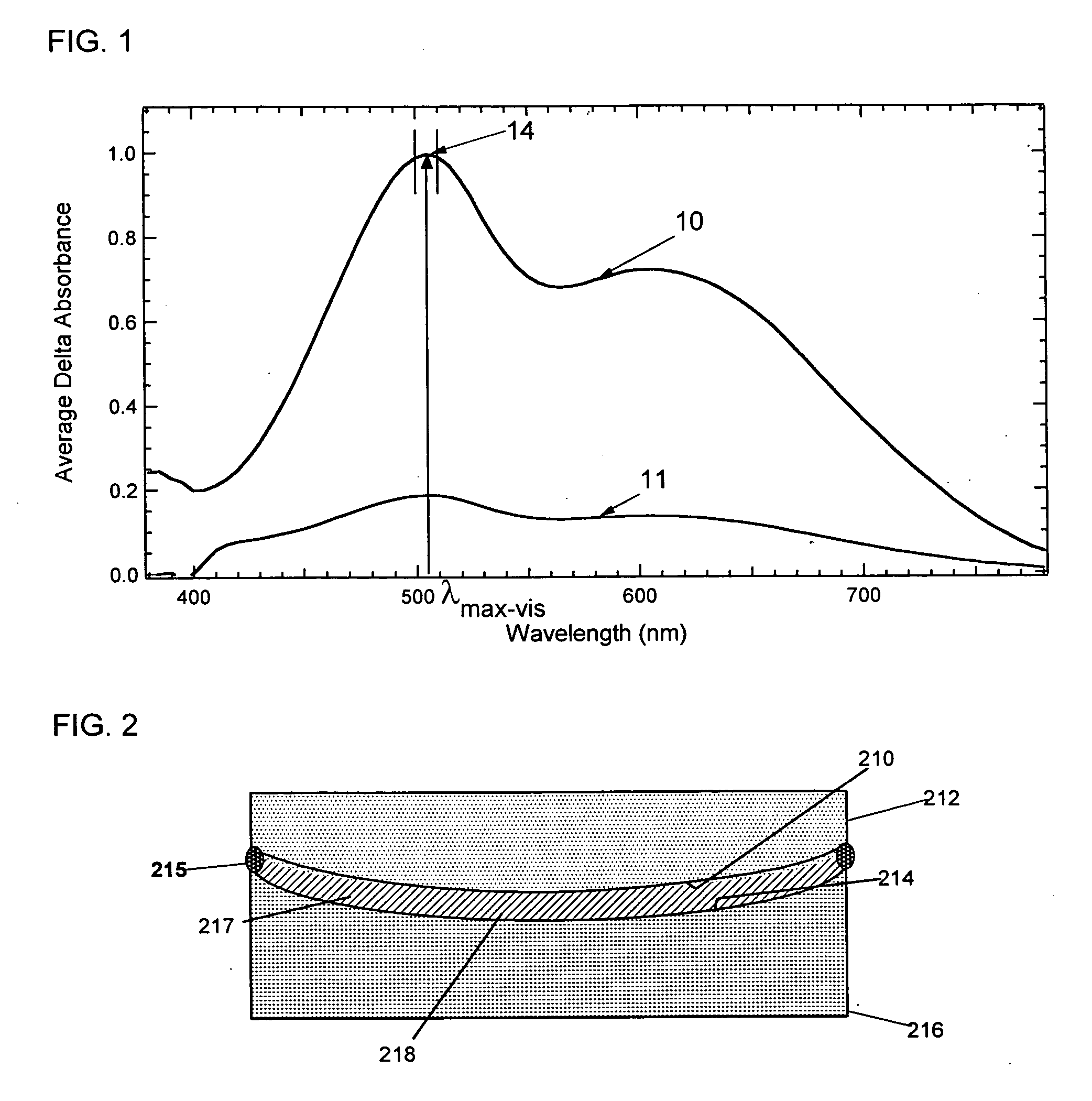Polarizing, photochromic devices and methods of making the same
a technology of photochromic devices and polarizing radiation, applied in the field of optical elements and security liquid crystal cells, can solve the problems of inability to reduce the glare of reflected light, conventional photochromic elements that do not include linearly polarizing filters, and inability to store or display information
- Summary
- Abstract
- Description
- Claims
- Application Information
AI Technical Summary
Problems solved by technology
Method used
Image
Examples
example 1
[0422] Sample substrates having a coating comprising an aligned anisotropic material and a photochromic-dichroic compound that was at least partially aligned in the activated state connected thereto were prepared as follows. A comparative substrate having a coating comprising an aligned anisotropic material and a commercially available photochromic dye that was at least partially aligned in the activated state connected thereto was also prepared as follows.
[0423] Part A: Preparation of Solutions of Anisotropic Materials
[0424] Each of the liquid crystal monomers listed in Table I were added to a beaker in the order listed with stirring:
TABLE ILiquid CrystalMonomerAmount (g)RM 2313.25RM 25723.25RM 8233.25RM 10543.25
1RM 23 is a liquid crystal monomer (LCM) available from EMD Chemicals, Inc and is reported to have the molecular formula of C23H23NO5.
2RM 257 is a liquid crystal monomer (LCM) available from EMD Chemicals, Inc and is reported to have the molecular formula of C33H32O10 ...
example 2
[0468] Ophthalmic substrates having an at least partial coating were prepared using an overmold process as described below.
[0469] Step 1
[0470] The procedure of Parts A & C of Example 1 were followed to form an overmolding coating composition, except that the essentially all of the solvent in the coating composition was removed by sparging with air for 2 hours prior to adding about 2 weight percent of P / D-3, on a total weight basis, to produce the overmolding coating composition.
[0471] Step 2
[0472] A six-base lens prepared from CR-39® monomer was cleaned following the procedure of Part D, Step 1 of Example 1 except that the lens was dried in an oven at 100° C. for 10 minutes prior to treatment with oxygen plasma.
[0473] Step 3
[0474] The procedure of Part D, Step 2 of Example 1 was followed to form an orientation facility comprising a coating of an at least partially ordered photo-orientable polymer network to the lens and a glass mold, except that a 90 second exposure to the lin...
example 3
[0478] An optical bench was used to measure the average absorption ratios for each of the coated samples prepared in Examples 1 and 2 above as follows. Each of the coated samples was placed on the optical bench with an activating light source (an Oriel Model 66011 300-Watt Xenon arc lamp fitted with a Melles Griot 04 IES 211 high-speed computer controlled shutter that momentarily closed during data collection so that stray light would not interfere with the data collection process, a Schott 3 mm KG-2 band-pass filter, which removed short wavelength radiation, neutral density filter(s) for intensity attenuation and a condensing lens for beam collimation) positioned at a 30° angle of incidence to the surface of the coated substrate.
[0479] A broadband light source for monitoring response measurements was positioned in a perpendicular manner to the surface of the coated substrate. Increased signal of shorter visible wavelengths was obtained by collecting and combining separately filter...
PUM
| Property | Measurement | Unit |
|---|---|---|
| wavelengths | aaaaa | aaaaa |
| weight percent | aaaaa | aaaaa |
| melting point | aaaaa | aaaaa |
Abstract
Description
Claims
Application Information
 Login to View More
Login to View More - R&D
- Intellectual Property
- Life Sciences
- Materials
- Tech Scout
- Unparalleled Data Quality
- Higher Quality Content
- 60% Fewer Hallucinations
Browse by: Latest US Patents, China's latest patents, Technical Efficacy Thesaurus, Application Domain, Technology Topic, Popular Technical Reports.
© 2025 PatSnap. All rights reserved.Legal|Privacy policy|Modern Slavery Act Transparency Statement|Sitemap|About US| Contact US: help@patsnap.com



